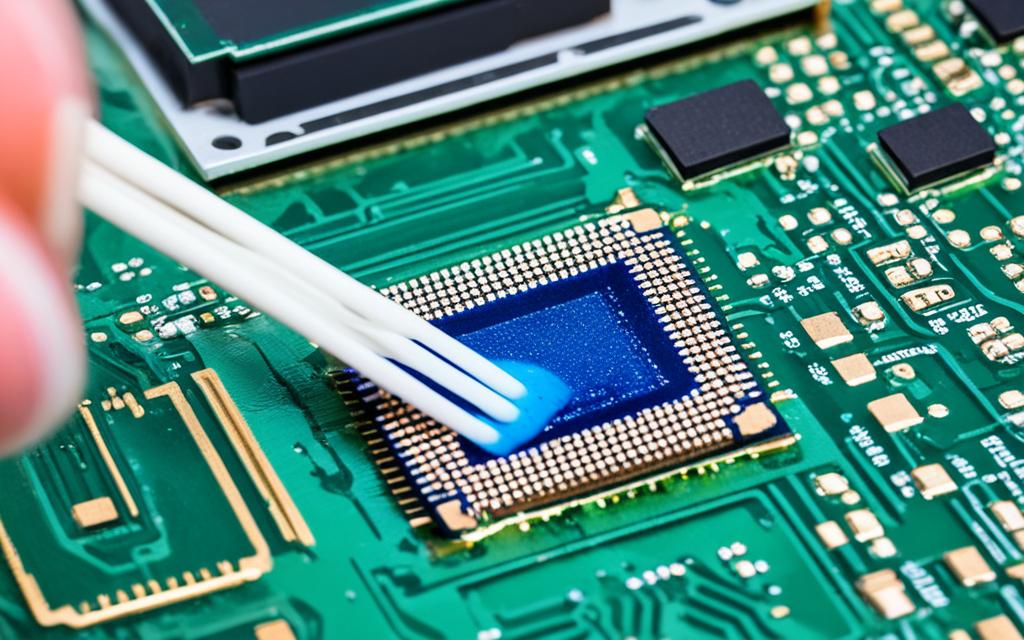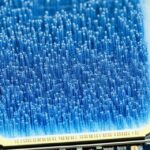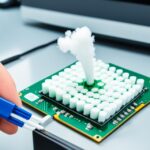Table of Contents
Thermal paste is key for CPU health but can cause problems if misapplied, especially to CPU pins. About 90% of CPUs should only get thermal paste on the Integrated Heat Spreader (IHS), not the pins1. If conductive thermal paste touches the pins2, over 95% of CPUs risk damage. Thus, learning how to remove thermal paste from CPU pins is vital. This article will guide you through the right steps to clean your CPU effectively. This way, you can ensure your CPU performs well by safely removing thermal paste.
Key Takeaways
- Apply thermal paste exclusively on the Integrated Heat Spreader.
- Utilise isopropyl alcohol of 91% or higher concentration for effective cleaning.
- Be aware of the risks of leaving thermal paste on CPU pins, including corrosion.
- Practice appropriate safety measures before beginning the cleaning process.
- Employ step-by-step techniques for thorough cleaning to avoid damage.
Understanding the Importance of Thermal Paste
Thermal paste is key for computer processors to work well and last long. It’s a must-have material that transfers heat from the CPU to its heatsink. Knowing what it is and how to use it is vital for anyone building or using a PC.
What is Thermal Paste?
Thermal paste fills tiny gaps to improve heat flow between surfaces. It’s most commonly used when fitting CPUs to ensure they stay cool. Not just for CPUs, but also for graphics cards and heat-generating parts, its use is essential in high-performance setups.
Why is Thermal Paste Necessary?
Applying thermal paste correctly is crucial for moving heat away from the CPU3. Without it, CPUs may overheat, leading to worse performance or even breakdowns. The best temperature for a CPU is between 40–55 degrees Celsius at rest and 65–80 degrees when busy3. Knowing the signs of a bad thermal paste job is important to ensure optimal heat management3.
Potential Risks of Improper Application
Applying thermal paste the wrong way can cause many problems. If paste touches CPU pins, it might stop them from working right, cause short circuits, or temperature issues4. Dirty CPU pins could lower performance, corrode, or wear out4. It’s important to apply paste carefully to avoid these issues and improve cooling.
| Aspect | Importance | Risks of Misapplication |
|---|---|---|
| Heat Transfer | Essential for optimal CPU operation | Overheating, performance degradation |
| Electrical Connectivity | Prevents short circuits | Corrosion, degradation |
| Application Quality | Affects thermal paste consistency | Signs of bad paste indicate failure |
The Risks of Thermal Paste on CPU Pins
Putting thermal paste on CPU pins can cause several problems. These can affect your computer’s performance and durability. It’s very important to understand these risks to keep your computer running well.
Electrical Conductivity Issues
Thermal paste, especially the type that conducts electricity, can cause electrical issues on CPU pins. If it spreads onto the pins, it might break the electrical connection with the motherboard. This can make the computer overheat, slow down, or even stop working5.
A user found their computer worked fine for more than 10 days after paste touched the CPU pins. This shows some pastes are safer, but you should still be careful6.
Impact on CPU Performance
Thermal paste on CPU pins can block heat from escaping. This extra heat can reduce the CPU’s speed and make the system crash5. Too much paste can also pressure or bend the pins, causing permanent damage5.
Challenges in CPU Removal
Removing a CPU can be hard if thermal paste sticks the CPU to the cooler. The paste’s stickiness could harm the pins if you try to pull the CPU out. Some users have broken their CPU pins this way during clean-up6.
To avoid these problems when removing the CPU, use pure isopropyl alcohol and a microfiber cloth7.
How to Get Thermal Paste Off CPU Pins
For the best cooling effect, it’s vital to remove old thermal paste from CPU pins. To do it right, you need the correct tools and a step-by-step cleaning process. Let’s look at what tools are needed and how to clean efficiently.
Essential Tools and Supplies for Cleaning
Start by gathering the necessary tools:
- Isopropyl alcohol (90% or higher for effective cleaning)
- Soft lint-free cloths
- Cotton swabs or balls
- Kitchen towels
- Non-conductive tweezers
- Latex gloves
- Anti-static wrist strap
- Soft-bristled cleaning brush
- Plastic scraper
These essentials will help you clean the thermal paste efficiently. Avoid damaging the pins by leaving the CPU in its socket during cleaning8.
Step-by-Step Cleaning Procedure
To properly clean, follow these steps:
- Gently remove the CPU from its socket, taking care not to bend any pins.
- Dip a cotton swab in isopropyl alcohol and carefully apply it to the paste.
- Use a lint-free cloth to carefully clean each pin. Avoid spreading paste onto the motherboard9.
- If you find hard-to-remove paste, use a soft brush or toothpick to gently remove it.
- Let the CPU and nearby areas dry fully before putting everything back together10.
Following this method refreshes your CPU and can improve its long-term efficiency. After cleaning, it’s wise to check the CPU’s temperature to see how well the new paste works.
Preparation for Cleaning CPU Pins
Before you start cleaning CPU pins, it’s vital to prepare carefully. Getting the right tools improves the cleaning and makes it smoother. Make sure to pick good quality CPU cleaning supplies to steer clear of any issues.
Gathering Necessary Supplies
First, get the supplies you’ll need like isopropyl alcohol (IPA) with at least a 90% concentration. This solvent is great for removing thermal paste quickly without leaving anything behind10. Then, grab some lint-free microfiber cloths or coffee filters for cleaning off any remaining paste.
Soft-bristled brushes, such as clean makeup brushes, will help you get rid of sticky thermal paste. For really tight spots, toothpicks or plastic picks can remove hard bits. Having these supply details ready makes the cleaning go well.
Safety Measures Before You Begin
Safety measures for cleaning are just as crucial. Always turn off and unplug your computer before you start. Wear an anti-static wrist strap to protect sensitive parts from static damage.
Use latex or nitrile gloves to keep oils off your hands and away from the CPU. Working in a clean, bright area helps you avoid losing any small pieces. This makes the whole process safer.
| Supply | Purpose |
|---|---|
| Isopropyl Alcohol (90%+) | Effective thermal paste removal |
| Lint-free Cloths/Coffee Filters | Wiping excess residue |
| Soft-bristled Brushes | Removing stubborn paste |
| Toothpicks/Plastic Picks | Extracting hardened thermal paste |
| Anti-static Wrist Straps | Preventing static discharge |
| Latex/Nitrile Gloves | Preventing contamination |
Conclusion
It’s vital to handle thermal paste on CPU pins well. This ensures your system works great and lasts long. Not cleaning off old thermal paste can cause overheating and lower efficiency. This can harm your CPU’s health over time. Our guide highlights the need to maintain CPUs by cleaning and replacing thermal paste when needed.
Using the cleaning methods we suggest can prevent damage from thermal paste leftovers. This keeps your CPU working well for longer. Regularly removing paste buildup on the pins helps with better heat management. This keeps your system running smoothly, even when it’s under heavy use. Check out this guide for extra tips on removing thermal paste.
To sum up, adopting these maintenance habits will make your CPU last longer and work better. Taking these steps ensures your computer runs efficiently for many years. A proactive approach to care is essential for making the most of your technology. Don’t forget, maintaining your CPU is crucial for keeping your tech investment safe111213.
FAQ
What is thermal paste and why is it important for CPUs?
Thermal paste is used to help CPUs stay cool. It fills the tiny gaps between the CPU and its heatsink. This makes sure the CPU doesn’t get too hot, which keeps it running well.
How can I safely remove thermal paste from CPU pins?
Start by getting a few things ready: isopropyl alcohol (91% or higher), soft cloths that don’t leave lint, cotton swabs, and tweezers that don’t conduct electricity. Carefully pick up the CPU. Then, use a cotton swab dipped in alcohol to gently clean each pin. Make sure it’s all dry before you put it back.
What are the risks of not removing thermal paste from CPU pins?
If you don’t clean off the thermal paste, it can cause electrical problems. This might make your system unstable or even damage it permanently. It also stops the CPU and motherboard from connecting properly, which lowers performance.
What should I do if thermal paste is stuck to the CPU?
If the thermal paste won’t come off, use isopropyl alcohol to help. Put some alcohol on the paste and wait for it to soften. Then, use a cotton swab to carefully clean it off. Be gentle to avoid damaging the pins.
What are some effective safety measures when cleaning CPU pins?
Make sure your computer is off and ground yourself to avoid static damage. It’s best to work in a place that’s clean and well-lit. Take care not to lose any small parts while you clean.
How often should I clean thermal paste from my CPU?
You should clean and replace the thermal paste every few years or if your CPU seems to be overheating. Keeping up with this maintenance can help your CPU work better for longer.
Source Links
- https://koolingmonster.com/insights/thermal-paste-on-cpu-pin-how-to-remove-thermal-paste-from-cpu-socket – Thermal Paste on CPU Pin? How to Remove Thermal Paste from CPU Socket? — Kooling Monster
- https://www.jawa.gg/blog/how-to-remove-thermal-paste-from-cpu-pins/ – How to Remove Thermal Paste from CPU Pins
- https://koolingmonster.com/insights/what-should-good-and-bad-thermal-paste-look-like-on-cpu – What Should Good and Bad Thermal Paste Look Like on CPU? — Kooling Monster
- https://softwareg.com.au/blogs/computer-hardware/got-thermal-paste-on-cpu-pins – Got Thermal Paste On CPU Pins
- https://softwareg.com.au/blogs/computer-hardware/thermal-paste-on-cpu-pins – Thermal Paste On CPU Pins
- https://www.techpowerup.com/forums/threads/a-little-bit-of-thermal-paste-on-the-pins-of-my-cpu-3600x.259577/ – a little bit of thermal paste on the pins of my cpu 3600x
- https://www.linkedin.com/advice/0/what-steps-clean-old-thermal-paste-from-your-4qhje – What are the steps to clean old thermal paste from your CPU?
- https://www.wepc.com/tips/how-to-remove-thermal-paste-from-cpu/ – How to remove thermal paste from a CPU
- https://www.electronicshub.org/clean-thermal-paste-off-cpu/ – How To Clean Thermal Paste Off CPU?
- https://www.jawa.gg/blog/how-to-clean-thermal-paste-off-cpu-pins/ – How to Clean Thermal Paste off CPU Pins
- https://forums.tomshardware.com/threads/thermal-paste-on-cpu-pins-and-motherboard-socket.3805939/ – Question – Thermal Paste on CPU Pins and motherboard socket
- https://community.spiceworks.com/t/make-your-own-thermal-paste-remover/433002 – Make Your Own Thermal Paste Remover?
- https://www.gizchina.com/2024/05/03/how-to-apply-and-clean-off-thermal-paste/ – How to Apply and Clean Off Thermal Paste








